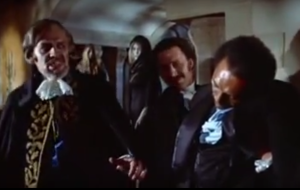Why Finally? Like a surprising number of Hammer films* and (until last year) Universal horror pictures, 1972’s Blacula was one of those glaring gaps in my education—and this despite years of being told how good it is. A viewing was overdue, probably by decades.
The Premise: In the late 18th century, African prince Mamuwalde (the splendid William Marshall) goes on a diplomatic mission to Castle Dracula in an attempt to curb the slave trade. This goes badly, as trips to Castle Dracula tend to do, and Mamuwalde is cursed with vampirism, christened Blacula by Vlad himself, and locked in a coffin for 190 years. When the castle’s furnishings are bought by some decorators and shipped to Los Angeles, the vampire rises—and quickly finds a woman who looks just like his late wife.

There follows a game of cat and mouse—once the police finally realize a series of exsanguination deaths deserves fuller investigation—led by a romantically partnered pair of scientists. Are they too late to defeat the forces of the undead, or will Blacula reclaim his bride?
Let’s get this out of the way: the vamp makeup in Blacula is often distracting. Some of his victims are completely green, and there’s a wide range of fangs at varying angles on display. Our titular villain gets bizarre facial hair when he vamps out: I enjoyed this, since it seems closer to the hairy-palmed Dracula that Stoker originally dreamed up, but it can be startling.
It shouldn’t detract from the story, though, which gives us an excellent antihero in Blacula. He’s been genuinely mistreated, had everything he valued taken away, and despises his own nature; it’s just not enough to stop the body count from rising, or to stop him from fighting back. And did I mention William Marshall is magnificent?
Readers, if any, know how much I enjoy tracing influences among movies/TV/books, and Blacula is a gold mine. It may be the first movie in which a vampire is haunted by the reincarnation of his lost love (though TV’s Dark Shadows seems to have done it first), an idea by now endemic to vampires generally and Dracula stories in particular. There are tiny details that were lifted almost verbatim by Love At First Bite. And there’s even an appearance by Elisha Cook (credited without his Jr.) as a hook-handed pathologist who suffers the eventual fate of most characters played by Elisha Cook.
My only problems with Blacula, apart from the terrible makeup effects, are ones I have with a number of old horror films—especially the syndrome I like to call vampnesia. (Vampnesia is, of course, a disease common to characters in horror movies in which “everybody’s heard of Count Dracula!”—at least enough to make fun of the people claiming they just saw him— but the good guys still must find an occult expert or make a trip to the local library’s folklore section in order to beat the baddie. I will never understand this.) The movie also has a case of “things spontaneously burning” reminiscent of the flammable stone mansion in The Haunted Palace, but hey, movie fire is fun.
The Verdict: All those people I mentioned above were right: Blacula is an excellent horror movie as well as an interesting cultural artifact. Even while rooting for the mortals, I was sad to see him go (is that a spoiler in a vampire movie, really?) and glad that there’s Scream Blacula Scream to bring him back.
Might go well with: rare steak, good music, anything crocheted.
*At least the ones not called [Something Something Something] Dracula.
Next time: The Quest(s) for the temple.